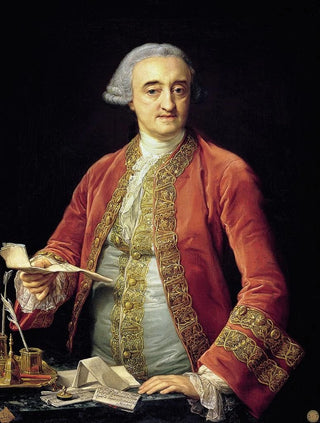Art print | Manuel de Roda et Arrieta - Pompeo Batoni


View from behind

Frame (optional)
Manuel de Roda et Arrieta art print by Pompeo Batoni – Engaging introduction
The Manuel de Roda et Arrieta art print by Pompeo Batoni evokes an era when art intertwined with daily life with rare elegance. This piece, capturing a moment in the life of an 18th-century man of letters, is much more than a simple depiction. It transports the viewer into a universe where culture and intellect meet, offering a fascinating glimpse into the society of the time. The soft light bathing the scene and the meticulous details of the costumes reveal not only the artist's talent but also the importance of intellectual exchanges in art history. Contemplating this work, one feels a connection with the ideas and aspirations of a bygone era, while being immersed in the visual beauty it exudes.
Style and uniqueness of the work
Pompeo Batoni's style is distinguished by his ability to fuse classicism and baroque, creating a refined and harmonious aesthetic. In "Manuel de Roda et Arrieta," every stroke, every shadow is carefully considered to emphasize the personalities of the characters. Batoni excels in representing textures, whether it is the rich fabrics of the clothing or the delicacy of the faces. The composition of the piece, with its subtle balance and judicious use of color, draws the eye toward the center of the action while maintaining an atmosphere of serenity. This artwork is not merely a simple illustration; it tells a story, that of a man engaged in thought and reflection, inviting the viewer to question their own beliefs.
The artist and his influence
Pompeo Batoni, an emblematic figure of the 18th century, made his mark through his innovative approach to painting. Originating from Lucca, Italy, he established himself in the Roman art scene, becoming one of the most sought-after portraitists of his time. His influence extends far beyond his contemporaries, impacting generations of artists who saw in him a model of technical virtuosity and emotional expression. Batoni captured the spirit of his era, blending classical influences with contemporary elements.

Matte finish

View from behind

Frame (optional)
Manuel de Roda et Arrieta art print by Pompeo Batoni – Engaging introduction
The Manuel de Roda et Arrieta art print by Pompeo Batoni evokes an era when art intertwined with daily life with rare elegance. This piece, capturing a moment in the life of an 18th-century man of letters, is much more than a simple depiction. It transports the viewer into a universe where culture and intellect meet, offering a fascinating glimpse into the society of the time. The soft light bathing the scene and the meticulous details of the costumes reveal not only the artist's talent but also the importance of intellectual exchanges in art history. Contemplating this work, one feels a connection with the ideas and aspirations of a bygone era, while being immersed in the visual beauty it exudes.
Style and uniqueness of the work
Pompeo Batoni's style is distinguished by his ability to fuse classicism and baroque, creating a refined and harmonious aesthetic. In "Manuel de Roda et Arrieta," every stroke, every shadow is carefully considered to emphasize the personalities of the characters. Batoni excels in representing textures, whether it is the rich fabrics of the clothing or the delicacy of the faces. The composition of the piece, with its subtle balance and judicious use of color, draws the eye toward the center of the action while maintaining an atmosphere of serenity. This artwork is not merely a simple illustration; it tells a story, that of a man engaged in thought and reflection, inviting the viewer to question their own beliefs.
The artist and his influence
Pompeo Batoni, an emblematic figure of the 18th century, made his mark through his innovative approach to painting. Originating from Lucca, Italy, he established himself in the Roman art scene, becoming one of the most sought-after portraitists of his time. His influence extends far beyond his contemporaries, impacting generations of artists who saw in him a model of technical virtuosity and emotional expression. Batoni captured the spirit of his era, blending classical influences with contemporary elements.






